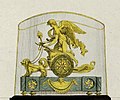
Palace of Fontainebleau or Château de Fontainebleau, located 55 kilometers southeast of the center of Paris, in the commune of Fontainebleau, is one of the largest French royal châteaux. The medieval castle and subsequent palace served as a residence for the French monarchs from Louis VII to Napoleon III. Francis I and Napoleon were the monarchs who had the most influence on the Palace as it stands today. It became a national museum in 1927 and was designated a UNESCO World Heritage Site in 1981 for its unique architecture and historical importance.

Neoclassicism was a Western cultural movement in the decorative and visual arts, literature, theatre, music, and architecture that drew inspiration from the art and culture of classical antiquity. Neoclassicism was born in Rome largely thanks to the writings of Johann Joachim Winckelmann, at the time of the rediscovery of Pompeii and Herculaneum, but its popularity spread all over Europe as a generation of European art students finished their Grand Tour and returned from Italy to their home countries with newly rediscovered Greco-Roman ideals. The main Neoclassical movement coincided with the 18th-century Age of Enlightenment, and continued into the early 19th century, laterally competing with Romanticism. In architecture, the style continued throughout the 19th, 20th and up to the 21st century.

An automaton is a relatively self-operating machine, or control mechanism designed to automatically follow a sequence of operations, or respond to predetermined instructions. Some automata, such as bellstrikers in mechanical clocks, are designed to give the illusion to the casual observer that they are operating under their own power. Since long ago, the term is commonly associated with automated puppets that resemble moving humans or animals, built to impress and/or to entertain people.

A cuckoo clock is, typically, a pendulum clock that strikes the hours with a sound like a common cuckoo call and has an automated cuckoo bird that moves with each note. Some move their wings and open and close their beaks while leaning forwards, whereas others have only the bird's body leaning forward. The mechanism to produce the cuckoo call has been in use since the middle of the 1700s and has remained almost without variation.

Mantel clocks—or shelf clocks—are relatively small house clocks traditionally placed on the shelf, or mantel, above the fireplace. The form, first developed in France in the 1750s, can be distinguished from earlier chamber clocks of similar size due to a lack of carrying handles.
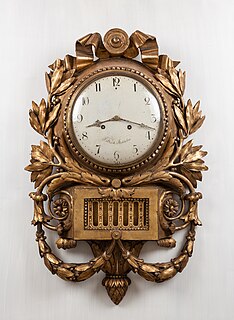
A cartel clock is a cartouche shaped clock designed to hang directly on a wall, very commonly executed in fire-gilt bronze. The form is a more unified development from a wall-mounted bracket clock standing upon its separate, complementary bracket characteristic of the Régence (1715–23), which continued to be stylish in Paris through the 1740s. In Paris, where the ébéniste's wooden contribution to the case and wall bracket, conceived as complements in design, was by degrees overshadowed by gilt-bronze mounts. wholly gilt-bronze bracket clock cases became most common by ca 1730. The cartel clock, incorporating clock case and bracket in a single unified organic sculptural conception, was a Rococo invention initiated in Paris. Highly ornate Rococo examples exist, with flowing, asymmetrical and curvilinear designs, the most notable being a series of unified cartel clocks in half a dozen related models, dateable to the 1730s and 40s and attributed to Charles Cressent.

Ormolu is the gilding technique of applying finely ground, high-carat gold–mercury amalgam to an object of bronze, and for objects finished in this way. The mercury is driven off in a kiln leaving behind a gold coating. The French refer to this technique as "bronze doré"; in English, it is known as "gilt bronze". Around 1830, legislation in France had outlawed the use of mercury for health reasons, though use continued to the 1900s.

The Empire style is an early-nineteenth-century design movement in architecture, furniture, other decorative arts, and the visual arts, representing the second phase of Neoclassicism. It flourished between 1800 and 1815 during the Consulate and the First French Empire periods, although its life span lasted until the late-1820s. From France it spread into much of Europe and the United States.

François-Honoré-Georges Jacob-Desmalter (1770–1841) oversaw one of the most successful and influential furniture workshops in Paris, from 1796 to 1825. The son of Georges Jacob, an outstanding chairmaker who worked in the Louis XVI style and Directoire styles of the earlier phase of Neoclassicism and executed many royal commissions, Jacob-Desmalter, in partnership with his older brother, assumed the family workshop in 1796. Freed from the Parisian guild restrictions of the Ancien Régime, the workshop was now able to produce veneered case-pieces (ébénisterie) in addition to turned and carved seat furniture (menuiserie). When his brother died, Jacob-Desmalter drew his father from retirement and began to develop one of the largest furniture workshops in Napoleonic Paris.
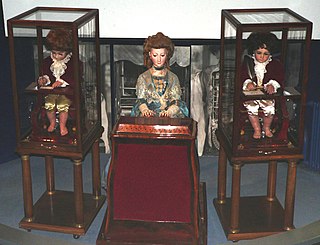
The Jaquet-Droz automata, among all the numerous automata built by the Jaquet-Droz family, refer to three doll automata built between 1768 and 1774 by Pierre Jaquet-Droz, his son Henri-Louis, and Jean-Frédéric Leschot: the musician, the draughtsman and the writer. The dolls are still functional, and can be seen at the Musée d'Art et d'Histoire of Neuchâtel, in Switzerland. They are considered to be among the remote ancestors of modern computers.
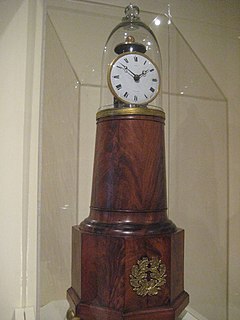
A lighthouse clock is a type of mantel clock manufactured in the U. S. from 1818 through 1830s by the American clockmaker Simon Willard, having the dial and works exposed beneath a glass dome on a tapered, cylindrical body.

Louis-Simon Boizot (1743–1809) was a French sculptor whose models for biscuit figures for Sèvres porcelain are better-known than his large-scale sculptures.

Pierre-Philippe Thomire (1751–1843) a French sculptor, was the most prominent bronzier, or producer of ornamental patinated and gilt-bronze objects and furniture mounts of the First French Empire. His fashionable neoclassical and Empire style furnishing bronzes established the highest standard in refined finish in the craft that the French called that of the fondeur-ciseleur, "founder-finisher". In his pre-Revolutionary training, Thomire appeared first as a ciseleur, in the division of duties that went into the production, for example, of a set of gilt-bronze wall-lights delivered for Marie-Antoinette's card-room, her Salon des Jeux at Compiègne: under the general supervision of Hauré, the wax and wooden model was carved by Martin, cast by Forestier, and chased by Thomire, as Pierre Verlet was able to show over fifty years ago.
Denière et Matelin were prominent French bronziers, producers of ornamental patinated and gilt-bronze objects and mounts working in Paris during the Directoire and First French Empire periods.

The petit appartement du roi of the Palace of Versailles is a suite of rooms used by Louis XIV, Louis XV, and Louis XVI. Located on the first floor of the palace, the rooms are found in the oldest part of the palace dating from the reign of Louis XIII. Under Louis XIV, these rooms housed the king's collections of artworks and books, forming a museum of sorts. Under Louis XV and Louis XVI, the rooms were modified to accommodate private living quarters. At this time, the rooms were transformed and their decoration represent some of the finest extant examples of the Louis XV style and Louis XVI style at Versailles.
The Watch Museum of Le Locle is a municipal museum specializing in horology, located in Le Locle, Canton of Neuchâtel, Switzerland. It is open to the public.
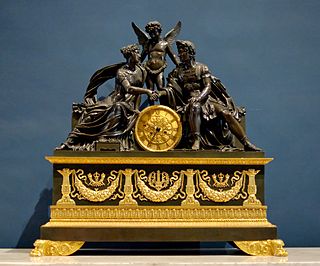
A French Empire-style mantel clock is a type of elaborately decorated mantel clock that was made in France during the Napoleonic Empire (1804–1814/15). Timekeepers manufacturing during the Bourbon Restoration (1814/1815–1830) are also included within this art movement as they share similar subjects, decorative elements, shapes, and style.
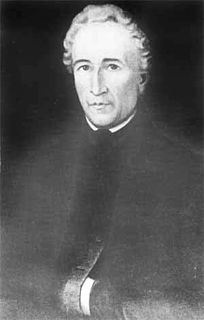
Jean-Antoine Lépine, born as Jean-Antoine Depigny, was an influential watchmaker. He contributed inventions which are still used in watchmaking today and was amongst the finest French watchmakers, who were contemporary world leaders in the field.

The Passemant astronomical clock is an astronomical clock designed by Claude-Simeon Passemant in the eighteenth century. It is displayed in the Salon de la pendule in the petit appartement du roi on the first floor of Versailles, France. The clock set the official time in France for the first time in the kingdom's history.

The Negress head clock is a type of French Empire mantel clock depicting the head of a black woman flanked by sculptured putti. It is considered among the eccentricities of French horology and had drawn attention during the late eighteenth century. Five examples are noted in prominent collections.





